| Zanthoxylum is my pick this month because I finally bought a specimen of the true Japan Pepper (sansho). In Seattle --at least-- misidentification of Zanthoxylum species is so common as to be almost assumed. Misidentification alone would not make me write about the genus. Even were they always correctly labeled, I enjoy the appearance of the plants, and their strikingly strong odor that recalls a spicy Citrus. It is impossible for me to see a Zanthoxylum and not touch it to release its fragrance. These plants are more known in the culinary and medicinal realms than in the ornamental horticulture one. Their warm zesty flavor is much relished. If you put it in your mouth for the first time, brace yourself for an amazing thrill. |
| Another reason I desire to popularize these shrubs and trees is because the east Asian species need more testing in Seattle, to determine how thirsty they are. Most east Asian trees and shrubs, accustomed to summer rainfall, find Seattle's dry summers uncomfortable; they can be stunted in growth and show premature fall color. I suspect that at least Zanthoxylum simulans is apt to prove the exception to this general rule. Why? Because in the wild some grow in relatively dry areas in well-draining sandy soil. |
| A valuable attribute of the species generally grown is their small size: they can be shrubs or small trees, hence can be planted in confined places. The fact that they are devoid of floral splendor doesn't much matter: their leaves are quietly attractive; their fragrance heady; and on some such as Zanthoxylum simulans the trunks are adorned with fascinating knobby spines that recall little rhinoceros horns to my imagination. |
| Earth has some 250 species of Zanthoxylum, including the species sometimes segregated as genus Fagara. Some older sources use the spelling Xanthoxylum. This is more etymologically proper, yet is "outlawed" because of botanists's insistence of the rule of priority: the first name, however uncouth or objectionable, takes precedence. In any case, as few plant names begin with either an X or a Z, the genus is special regardless. In 1753 Linnæus used the pre-existing name and spelling Zanthoxylum. |
| In Greek xanthos means yellow. Genus Xanthoceras is called Yellowhorn; Xanthorhiza yellowroot; and you would think logically that Zanthoxylum is yellowwood. But the latter English name is applied in the northern hemisphere to Cladrastis trees, and in the southern hemisphere to various species of Podocarpus. In English, the species of Zanthoxylum tend to be called as I indicate below. |
| Zanthoxylum are widespread, deciduous or evergreen, usually prickly, trees, shrubs, or viney. As far as I know, all release a characteristic strong odor. Most have compound and obliquely-based rather than simple leaves. When you hold a leaf up against a light source you can see little specks (oil glands) where light shines through. These are diagnostic of the whole Rue Family RUTACEÆ. Most species of Zanthoxylum are cold-tender in Seattle. A comparative miserly handful have been planted here. I will concentrate my remarks on those five. If you know of other species grown in Seattle, I eagerly wish to learn of them. |
In my remarks I will ignore the active constituents of the species, such as render them used for certain medicinal roles (e.g., toothaches, sickle-cell anemia, gonorrhea, heart trouble, bellyache, burns). There is much information available elsewhere on this topic. Below I merely sort the several species that grow in Seattle.
|
| Zanthoxylum piperitum (L.) DC. 1824 |
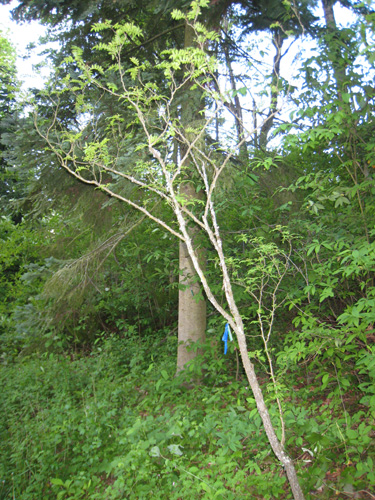
Zanthoxylum piperitum photo by ALJ
|
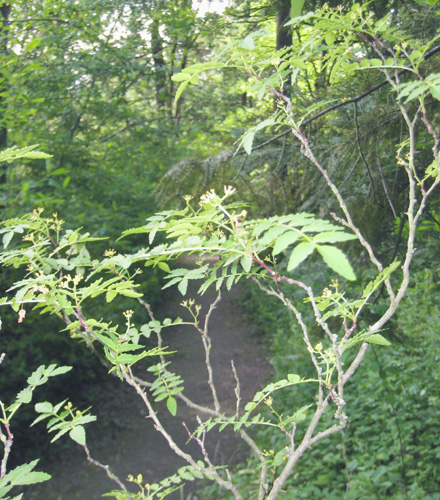
Zanthoxylum piperitum photo by ALJ
|
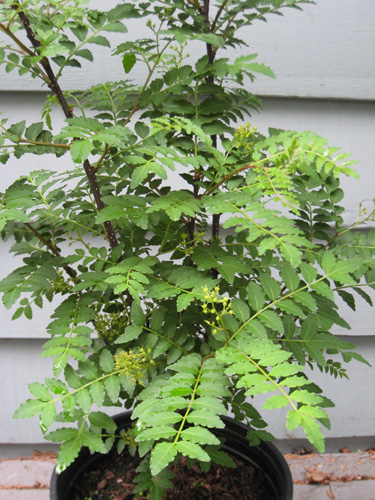
Zanthoxylum piperitum photo by ALJ
|
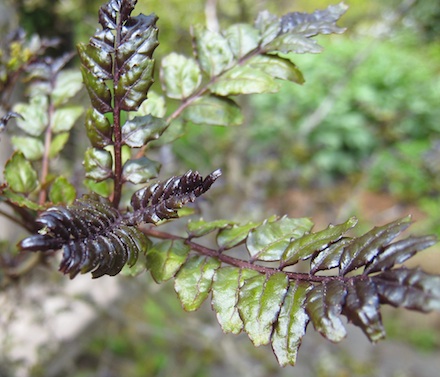
Zanthoxylum piperitum purple photo by ALJ
|
| From Japan and Korea, cultivated in China, this is a deciduous, small-leaved shrub or tiny tree; male and female flowers on different specimens. It likes warm, moist sites. In English it is Japan(ese) Pepper. The Japanese name is Sansho [サソショウ]. The Japanese believe that snakes are kept from their gardens by planting it. Its twigs are stout, its growth is ascending. The leaves are dark green, 3 to 6 inches long, consisting of 11 to 23 petite leaflets. The twigs bear paired short prickles. In April or May (even June), it bears greenish-yellow tiny flowers devoid of petals. They are barely noticed. It was introduced to Western cultivation in 1877. Some books say it can become a small tree. Every one I have seen is shrub-sized, and the tallest are one 16.5 feet at Kruckeberg Botanic Garden in Shoreline, just north of Seattle, and one 8 feet in Washington Park Arboretum, dating from 1958 (#733-58A in grid 4-1E). It is easily kept 3 or 4 feet tall by pruning. |
| There are versions with short spines, no spines, and one with purple young leaves. The young leaves are edible as spicy pepper-hot condiments; as are they dried and powdered; as are the dried, ground, little pink seed-capsules made by female specimens. This spice is used on meats, grilled eggplants, and so on. The wood, which is indeed yellowish, is prized for small implements such as walking sticks and food pestles. |
In Seattle cultivation, people have bought specimens (and seeds) labeled Z. piperitum, only to find out they really had been sold Z. simulans or Z. schinifolium. At Washington Park Arboretum, a plant with the accession number 369-89A is a female Z. simulans that ever since 1989 has been wrongly labeled Z. piperitum. It makes viable seeds. Some nurserymen have raised seedlings from it and sold the offspring under the wrong name. My photo shows the correctly identified specimen that I bought at the Children's Hospital Plant Sale. At Kruckeberg Botanic Garden is a 16.5 feet tall female specimen, very crowded for light. The MsK nursery there has a 5-gallon Z. simulans for sale labeled as "Japan Pepper."
|
| Zanthoxylum schinifolium S. & Z. 1846 |
| =Z. mantchuricum Benn. 1862 |
| =Fagara schinifolia (S. & Z.) Endl. 1888 |
| =Fagara mantchurica (Benn.) Honda 1932 |
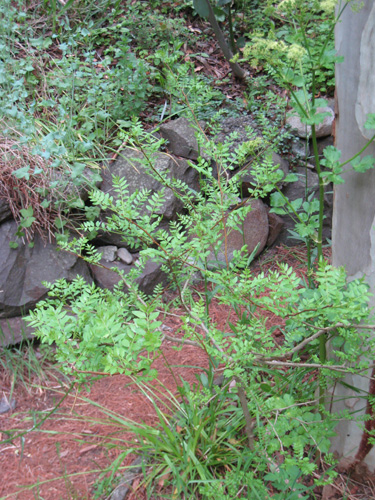
Zanthoxylum schinifolium photo by ALJ
|
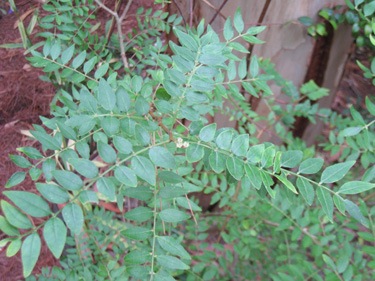
Zanthoxylum schinifolium photo by ALJ
|
| From woodlands of east Asia, similar to Z. piperitum, another deciduous, small-leaved shrub. Sometimes sold wrongly as Z. piperitum. It differs in several aspects: more cold-hardy; the twigs are slender rather than stout, they are not so densely borne nor upswept; they bear prickles singly rather than in pairs; and it blooms later: in (July) August into September. It is highly variable in foliage. The leaves are 3 to 7 inches long, of 11 to 25 tiny leaflets; they can be hairy. Prevalent Chinese names transliterated are spelled: Yai-chiao (meaning Cliff Pepper), T'u-hua-chiao, or Qing-hua-iao (青花椒). The Japanese call it Inu-zansho [イヌサソショウ], meaning "dog-" or "false" Zanthoxylum piperitum. |
It has been less cultivated in the West than Zanthoxylum piperitum; it is said to have been introduced here in 1872. I bought one (as Z. piperitum) from Heronswood nursery in 1999; it is still less than 5 feet tall. My first photo shows it right next to the pale trunk of my towering Eucalyptus Dalrympleana, and there is a Smyrnium Olusatrum blooming, too. My second photo shows its tiny male flowers on September 26th. Heronswood listed Zanthoxylum schinifolium in its catalogs from 1992 through 1995. The only other specimen I know of locally is owned by Dan Corum, the Zoo Doo man. Like mine his is a male.
|
| Zanthoxylum simulans Hance 1866 |
| =Z. Bungei Planch. 1853, non Hance 1866 |
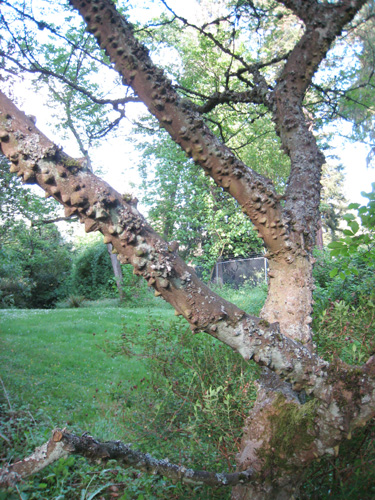
Zanthoxylum simulans trunk photo by ALJ
|
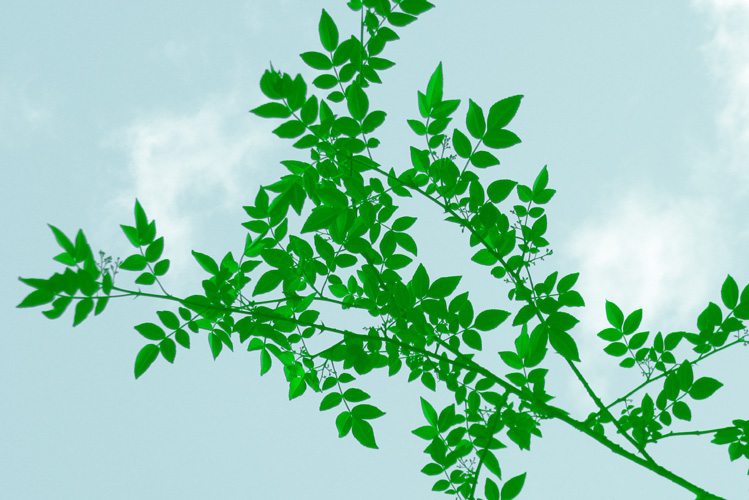
Zanthoxylum simulans foliage photo by ALJ
|
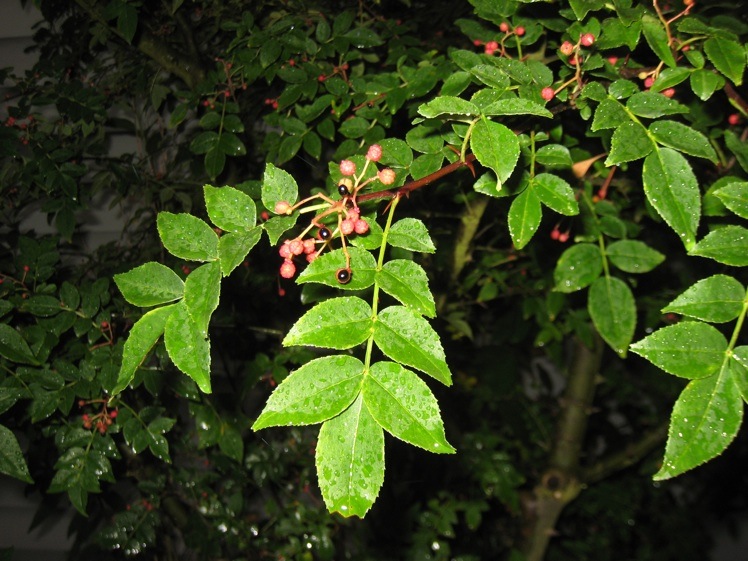
Zanthoxylum simulans in seed photo by ALJ
|
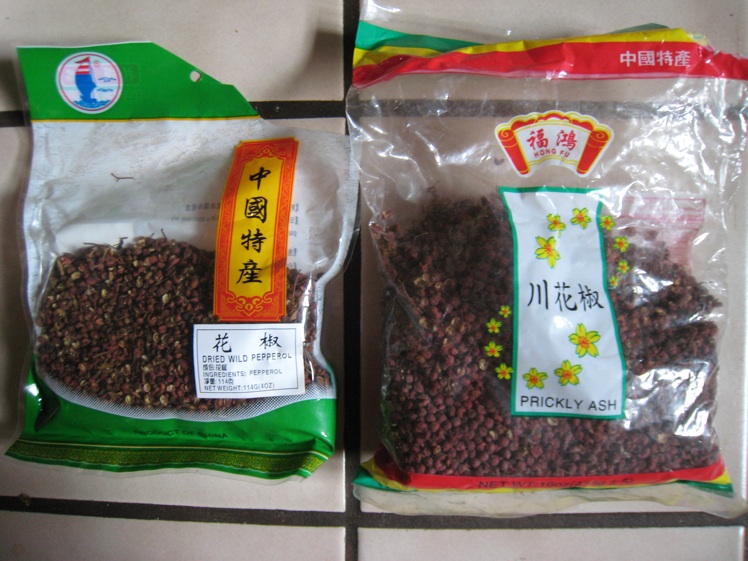
Zanthoxylum simulans seeds photo by ALJ
|
| From woodlands and open areas of China and Taiwan, odd in that it is almost invariably listed as a shrub, while every one I know in Seattle is single-trunked and acting like a little tree. Yet I have only seen 12 that I recall in Seattle, and they likely are all virtually the same genetic stock. Charles Sargent, in Plantæ Wilsonianæ (1916), wrote that in central and western China it was both wild and commonly cultivated. "This species is the only one we have seen cultivated by the Chinese and its fruits are their most prized condiment." The prevalent Chinese names transliterated are spelled: Ye-hua-jiao, Hua-chiao (Hwa-chiao; 花椒) (meaning Flower Pepper). Cultivated in the West since 1864. In English it is Sichuan (Szechwan) or Chinese Pepper. |
| The Washington Park Arboretum has two trees of it dating from 1969. To the north is #348-69A, and 25 feet to the south is #348-69B. The latter is 27 feet tall, wider than tall, its trunk 7 inches thick. It is female. The tree to the north is perhaps 28 feet tall, but the shading it grows in makes exact height measurement impossible, and its flowers are out of reach so I cannot tell their gender. It, unlike the southern specimen, also has sent up some root suckers. Both of these suffer from too much shade. Sixty feet to the west is the aforementioned #369-89A Z. simulans wrongly labeled Z. piperitum. It is an 11 foot tall female. I saw a seedling at its base this month. |
| This species looks different from Z. piperitum and Z. schinifolium because it is stout and treelike. It has substantial knobby thorns (not little prickles), and the leaves, while only 3 to 5 (9) inches long, have few and larger leaflets: 5 to 11 (15). It stays green late into fall, and the dull red, warty fruits are mildly ornamental, especially when they open to reveal their shiny black seeds. Eventually it makes a dingy yellow fall color. It flowers from May into July, depending on clone, year and locale. The bees really love these flowers I have noticed. The female flowers are green with 3 naked stigmas; no anthers or petals. |
Colvos Creek Nursery of Vashon has been selling Z. simulans for some 15 years or more. I have seen even isolated female specimens bear viable seeds, so I presume they can thereby clone themselves. The University of Washington Medicinal Herb Garden has 6 specimens raised from "Z. piperitum" seeds mailed from botanical gardens in Germany and Switzerland. Three of the 6 are old enough to bloom and are all female.
|
| Zanthoxylum armatum 1824 var. subtrifolilatum (Franch.) Kitam. 1972 |
| =Z. alatum var. planispinum (S. & Z.) Rehd. & Wils. 1914 |
| =Z. planispinum S. & Z. 1846 |
| =Z. Bungei Hance 1866, non Planch. 1853 |
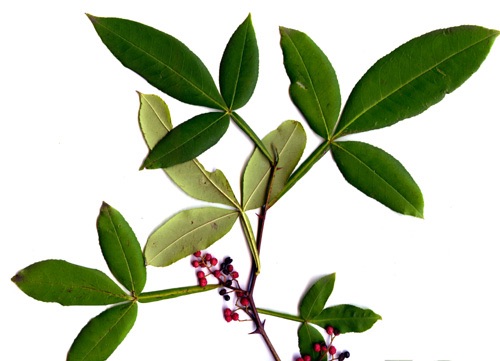
Zanthoxylum armatum scan by ALJ
|
| From woodlands of China, Taiwan, S Korea, Japan and the S Ryukyus. Cultivated in the West by the 1870s. Charles Sargent, in Plantæ Wilsonianæ (1916), wrote that it is a shrub abundant throughout the warmer parts of central and western China. Chinese names transliterated are spelled: Chu-yeh-chiao (meaning Bamboo-leaf Pepper), Kou-hua-chiao, or Zhu-ye-hua-jiao. In English it has been called the Winged Prickly-Ash or Peppertree. This variation differs from typical Z. armatum (Pakistan, N India, Burma) in having 3 to 5 (7) rather than 5 to 11 leaflets. Some botanists judge that it is not worthy of naming separately. The leaf stem is winged boldly. |
| Very different from the preceding three species, it is more or less evergreen, with only 3 relatively huge leaflets --the terminal one can be fully 5 inches long. In Japan it is the Fuyu-zansho [フユサソショウ] meaning "winter" Zanthoxylum piperitum. The spines are paired. The flowers are in May or June, devoid of petals. This species is relatively cold-tender. |
I first made a note of it in January 2004 at the Kent garden of George Pinyuh. The twig I scanned came from there. You will observe it is female, with seeds. There is also a specimen at Kruckeberg Botanic Garden. Pinyuh obtained his plant from Art Kruckeberg. Kruckeberg says he likely got it from Carl English (1904-1976). Kruckeberg's plant is 10 feet tall, 15 feet wide, and sprawled under a big Leyland Cypress in the parking area. As with Z. piperitum and Z. simulans, the young tender leaves and the dried fruits are used as a spice.
|
| Zanthoxylum americanum Mill. 1768 |
| =Z. fraxinifolium Marsh. 1785 |
| =Z. fraxinium Willd. 1806 |
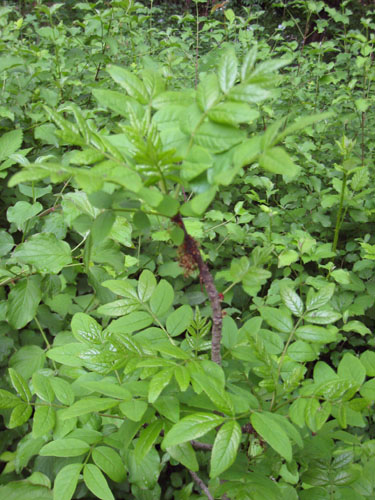
Zanthoxylum americanum photo by ALJ
|
From open areas of Canada and New England south to Oklahoma and South Carolina. It is a shrubby small tree, at most 25 feet tall, called the Common- or Northern- Prickly-Ash, or Toothache Tree. Because it spreads by suckers to form prickly thickets, and its flowers are dull and fall color ho-hum yellow-gold, it is not valued ornamentally. The only one I know in Seattle is a male youngster planted about 2004 at the University of Washington Medicinal Herb Garden (see my photo). It had been received in 1998 from Forest Farm. One had been planted in 1950 at Washington Park Arboretum, but died. This species blooms in spring before the leaves come out. My photo shows the wilted flowers under the leaf clusters. The leaves are 6 to 8 inches long, consisting of 5 to 11 leaflets, hairy beneath. It contains insecticides similar to pyrethrins. To thrive, the Medicinal Herb Garden specimen may need more sun than it gets.
|
Four more taxa that might exist --albeit extremely rare-- in Seattle:
|
| Z. ailanthoides S & Z. 1846 |
| Devil's Pepper-tree. |
| A 60-foot tall East Asian tree. |
Sold from 1992 through 1995 by Heronswood Nursery.
|
| Z. Clava-herculis L. 1753 |
| Hercules' Club, Southern Prickly-Ash or Toothache Tree. |
A tree, sold off and on by mail-order nurseries such as Forest Farm, Woodlanders, etc.
|
| Z. affin. diacanthoides |
| East Asian shrub. |
Sold from 1999 through 2001 by Heronswood Nursery. Said to be Eric Hammond's 1997 seed collection from west China at 6,500 feet elevation. Since there is no such thing as Z. diacanthoides, I suspect this was an error for Z. ailanthoides.
|
| Z. nepalense Babu 1974 |
Sold from 1997 through 2005 by Heronswood Nursery.
Back |

